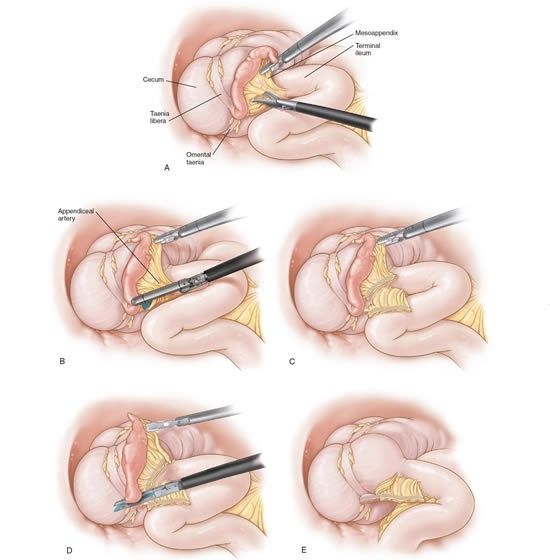Laparoscopic Appendicectomy is method of choice for Pediatric Patients
Dear members,
Welcome to our July 2011 Newsletter of World Laparoscopy Hospital. As promised, we are continuing to advance into the fields of General Surgery and Gynecology in our coverage of operative techniques and videos. In expanding our focus on different surgical specialties, we hope to engage the interest of more of our member surgeons and gynecologist. Please remember that your feedback is vital to our development!
New Releases
Preoperative section
Digestive surgery
Hernias: diagnosis, indications and treatment
The Nyhus classification describes different types of hernia. All hernias can be complicated by strangulation, which is considered a surgical emergency. By definition hernia is a diverticulum of the parietal peritoneum, usually containing viscera, and they develop through an opening or natural weakness in the abdominal wall. Inguinal, femoral and umbilical hernias occur the most frequently.
Operative techniques
Urology
Laparoscopic treatment of ureteropelvic junction obstruction in adults. Ureteropelvic junction (UPJ) obstruction is a major cause of hydronephrosis. While conventional treaments such as Anderson-Hynes (dismembered) pyeloplasty and endoscopic retrograde or antegrade techniques are also used, laparoscopy for reconstructive procedures has made it possible to maintain the good functional results obtained by open surgery while avoiding approach-related sequelae. Laparoscopic pyeloplasty may be performed via a transperitoneal or a retroperitoneal approach.
Laparoscopic treatment for genitourinary prolapse. Genitourinary prolapse is a frequent pathology in postmenopausal women. It is characterized by a deformation of the vagina caused by the prolapse of pelvic or abdominal organs. Prolapse repair can be performed via the high transabdominal approach and the low transvaginal approach. Advocates of the transabdominal procedure have developed a laparoscopic approach to avoid a wide incision on the anterior abdominal wall.
Gynecology
Laparoscopic Myomectomy. Pelvic lymphadenectomy can influence the therapeutic strategy, especially when a combination of treatments is proposed. The transperitoneal approach permits a complete exploration of the peritoneal cavity.
Pediatric surgery
Pediatric Appendectomy is usual in children, but the use of ultrasound examination has led to higher rates of diagnosis. Benefits such as reduced hospitalization and discomfort have led to the adoption of the laparoscopic approach to appendectomy as the gold standard in adults and in children.
Yours faithfully,

Dr. R. K. Mishra
Chairman and Director
World Laparoscopy Hospital
Welcome to our July 2011 Newsletter of World Laparoscopy Hospital. As promised, we are continuing to advance into the fields of General Surgery and Gynecology in our coverage of operative techniques and videos. In expanding our focus on different surgical specialties, we hope to engage the interest of more of our member surgeons and gynecologist. Please remember that your feedback is vital to our development!
New Releases
Preoperative section
Digestive surgery
Hernias: diagnosis, indications and treatment
The Nyhus classification describes different types of hernia. All hernias can be complicated by strangulation, which is considered a surgical emergency. By definition hernia is a diverticulum of the parietal peritoneum, usually containing viscera, and they develop through an opening or natural weakness in the abdominal wall. Inguinal, femoral and umbilical hernias occur the most frequently.
Operative techniques
Urology
Laparoscopic treatment of ureteropelvic junction obstruction in adults. Ureteropelvic junction (UPJ) obstruction is a major cause of hydronephrosis. While conventional treaments such as Anderson-Hynes (dismembered) pyeloplasty and endoscopic retrograde or antegrade techniques are also used, laparoscopy for reconstructive procedures has made it possible to maintain the good functional results obtained by open surgery while avoiding approach-related sequelae. Laparoscopic pyeloplasty may be performed via a transperitoneal or a retroperitoneal approach.
Laparoscopic treatment for genitourinary prolapse. Genitourinary prolapse is a frequent pathology in postmenopausal women. It is characterized by a deformation of the vagina caused by the prolapse of pelvic or abdominal organs. Prolapse repair can be performed via the high transabdominal approach and the low transvaginal approach. Advocates of the transabdominal procedure have developed a laparoscopic approach to avoid a wide incision on the anterior abdominal wall.
Gynecology
Laparoscopic Myomectomy. Pelvic lymphadenectomy can influence the therapeutic strategy, especially when a combination of treatments is proposed. The transperitoneal approach permits a complete exploration of the peritoneal cavity.
Pediatric surgery
Pediatric Appendectomy is usual in children, but the use of ultrasound examination has led to higher rates of diagnosis. Benefits such as reduced hospitalization and discomfort have led to the adoption of the laparoscopic approach to appendectomy as the gold standard in adults and in children.
Yours faithfully,

Dr. R. K. Mishra
Chairman and Director
World Laparoscopy Hospital


